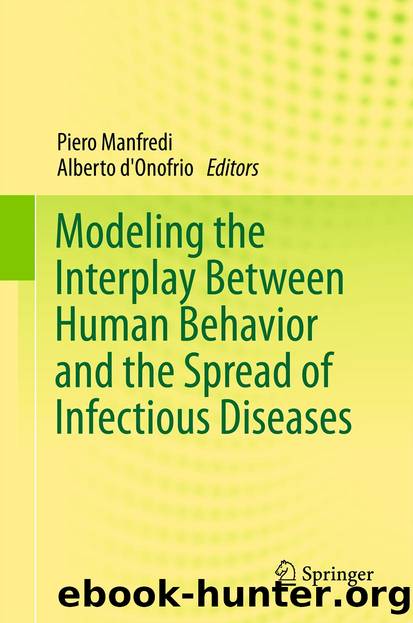Modeling the Interplay Between Human Behavior and the Spread of Infectious Diseases by Piero Manfredi & Alberto D'Onofrio

Author:Piero Manfredi & Alberto D'Onofrio
Language: eng
Format: epub
Publisher: Springer New York, New York, NY
(8)
where q is the expected time until recovery (calculated as 1 ∕ P i, z , where ). The intrinsic growth rate, r, can be calculated assuming an initial exponential epidemic growth phase, where
(9)
and where y is the curve of cumulative incidence at time t, A is a constant, and ε is a mean zero error term [14]. The value of r is estimated by linear regression following a log transformation of Eq. (9). The forecast resulting from this model is then provided as the forecast for the state variables out to the planning horizon. We refer to this as the R 0-based forecast.
The second phenomenological model simulates a time series analysis. We use the two-day running average to fit a third-order polynomial to the time series of prevalence. The next T elements in the series following the polynomial are used as forecasts for the expectations about S and I populations. We refer to this as the simulated time series forecast.
A few comments about these forecasting models are in order. First, we do not include any stochastic shocks in our simulations. The data generating mechanisms for our estimated models are deterministic at the system level. Second, all residual error, ε, comes from misspecification because the phenomenological models ignore changing behavioral dynamics. We believe this approach is informative because to our knowledge models that jointly estimate behavioral response and disease dynamics have not yet been developed. Indeed, Geoffard and Philipson [26] point out that the development of such models is likely to be a nontrivial problem. In addition to alternative expectations models, we vary the rate of at which new information becomes available so that information is less timely but not inherently corrupted. We also explore alternative parameterizations of the utility function. We simulate each model on a daily time step using parameters from [20] repeated here in Table 1, and use a planning horizon of 12 days, twice the expected recovery time. Table 1Parameter values used in the simulations
Download
This site does not store any files on its server. We only index and link to content provided by other sites. Please contact the content providers to delete copyright contents if any and email us, we'll remove relevant links or contents immediately.
When Breath Becomes Air by Paul Kalanithi(7294)
Why We Sleep: Unlocking the Power of Sleep and Dreams by Matthew Walker(5680)
Paper Towns by Green John(4191)
The Immortal Life of Henrietta Lacks by Rebecca Skloot(3843)
The Sports Rules Book by Human Kinetics(3613)
Dynamic Alignment Through Imagery by Eric Franklin(3511)
ACSM's Complete Guide to Fitness & Health by ACSM(3481)
Kaplan MCAT Organic Chemistry Review: Created for MCAT 2015 (Kaplan Test Prep) by Kaplan(3437)
Introduction to Kinesiology by Shirl J. Hoffman(3317)
Livewired by David Eagleman(3154)
The River of Consciousness by Oliver Sacks(3008)
Alchemy and Alchemists by C. J. S. Thompson(2924)
The Death of the Heart by Elizabeth Bowen(2921)
Descartes' Error by Antonio Damasio(2757)
Bad Pharma by Ben Goldacre(2744)
The Gene: An Intimate History by Siddhartha Mukherjee(2510)
Kaplan MCAT Behavioral Sciences Review: Created for MCAT 2015 (Kaplan Test Prep) by Kaplan(2501)
The Fate of Rome: Climate, Disease, and the End of an Empire (The Princeton History of the Ancient World) by Kyle Harper(2452)
The Emperor of All Maladies: A Biography of Cancer by Siddhartha Mukherjee(2446)
